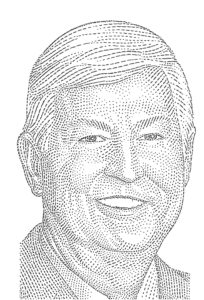Details Are Part of Our Difference
Embracing the Evidence at Anheuser-Busch – Mid 1980s
529 Best Practices
David Booth on How to Choose an Advisor
The One Minute Audio Clip You Need to Hear
A Moment of Reflection: Something to Celebrate

This time of year, people are buzzing about New Year’s resolutions, guessing what the tax changes will be, and all sorts of anxiety-provoking topics.
But you, you’re different. Give yourself a huge pat on the back. You can congratulate yourself on checking the box on most, if not all, of your financial resolutions – for this year and next! Why?
You’re a Hill Investment Group client. With that single decision, you get to delegate your worry to us, benefitting from:
- A long-term, low-cost, tax-efficient, and globally diversified investment portfolio
- A financial plan grounded in your personal goals, your family, the causes, and organizations that you genuinely care about
- A disciplined, evidence-based investment strategy
- Tax-aware investment moves made throughout the year
- Planning strategies that maximize the value of vehicles and benefits available to you
- Proactive strategies that guide you towards the legacy you hope to leave
- And the list goes on!
So. Now what? By checking off all of the above, take a few minutes and think about those long-term goals, your family, your health. What will you resolve to start doing or stop doing with this freedom? What can you do that will enhance your health span, your relationships, the odds that you’ll check off some bucket list items. Do that.
And while you do that, the Hill Investment Group team will continue to do our part to eliminate worry and deliver peace of mind. Our mission is to walk you towards a higher level of financial freedom. We thank you for making us part of your family. It’s great company to be in!
If you’re not a client and want to check off a few items on your New Year’s resolution list, call us or set up a time to get together…face to face or virtually. Cheers!
New Video – PJ McDaniel
When a new client starts their relationship with Hill Investment Group, we ask what made them select us. Often responses are some version of, “We were told you really care, and our meetings with you confirmed that you do.” We agree and are thankful. We really do care, and PJ McDaniel is the person in charge of demonstrating our intentions with new families. Take two minutes to watch PJ McDaniel’s video. I bet you’ll feel how much PJ wants to help families get the kind of financial guidance they deserve…and have been in search of.
It’s hard to imagine someone more likable than PJ. He’s a partner in our firm, leads our business development efforts, and is known for his positive focus. PJ estimates that he’s met over 8,000 advisors through his prior career. He’s said that he picked the best firm of the bunch when he joined HIG. It’s nice of him to say, but we’re the lucky ones. There is no better person to introduce new families to our evidence-based investment philosophy and Take the Long View approach. I’m proud to call PJ my business partner and hope that you consider him as your partner as well.
If you want to get to know PJ even better, set a time to talk or meet with him here.
NEW Series From Rick – The Most Important Lessons From My 50+ Years of Investing

Why would a stockbroker leave the office for lunch and end up spending the afternoon at a movie theater watching a Clint Eastwood triple feature? It’s hard to imagine a broker abandoning work in the middle of the trading day, but that broker was me. To understand what drove me into that darkened theater, you need to know what I was going through at the time—and how that experience contributed to one of the most important lessons I’ve learned during my 50+ year career in finance.
My fascination with the stock market began when I took my first investment class at Wharton Business School in 1967 during my MBA program. Investing was a new world to me (my father and grandfather weren’t investors—they both had pensions), and from that day on I wanted to learn as much as possible. I read investing books, followed the market’s movements in the newspaper and on TV, and listened to many so-called experts. It’s no surprise that this interest led me to a career in the investing world.
Along the way, though, I discovered that most of what you hear and read doesn’t teach you what you need to know to be a successful investor in the real world. Too often, investment “advice” is focused on specific products, like the stocks or mutual funds, or annuities, that someone wants you to buy. However, you can’t make sound investment decisions and manage your emotions without a grounding in the principles that lead to financial success. For me, I had to gain that knowledge through experience.
Some of those experiences were painful and humbling. Others were empowering. Now, more than 50 years into my journey to become a better investor, I want to share some of these stories and their lessons. I hope you can take something from my experiences to help put you on your path to investment success.
Investment class at Wharton—1966
A particular moment from my first investing class at the University of Pennsylvania made a big impression on me. One day, our professor asked us to calculate how much money we would have at retirement according to the following assumptions:
- We saved 10% of our starting salary the first year after graduation and continued saving 10% of our salary for the next 40 years
- Our salary would grow by 5% a year
- Our investments would earn 10% a year
I assumed a starting salary of $12,000 (which was a little optimistic—it turned out to be about $9,000), and then I began doing the math. We did not have computers back then, so I had to use manual calculations to work through all the figures. When I was done, I had an ending value of $1 million at age 64 in 2007.
I remember thinking this had to be a mistake. A million dollars was practically unheard of back then unless you were very wealthy.
I checked my work and got the same result. That’s when I realized that it was possible to become a millionaire by age 65 with a couple of reasonable assumptions—and a disciplined saving and investing strategy.
Lesson Learned: Compounding works wonders if you let it work.
Every retirement guide will tell you that starting to save early and keeping it up is the key to success. But it can be hard to stick with that approach because you must be willing to delay your gratification and ignore the noise around you – good and bad.
Investing doesn’t reward you consistently year after year. Some years you might not make much progress; other years, you might fall back a bit. Likewise, compounding isn’t exciting from one year to the next. Over long periods, though—like the 40 years you might spend saving for retirement—it’s going to make a big difference.
Clients and team members I work with have already experienced what compounding can do. They’ve been saving and investing for long enough that they can look back to where they were 20 years ago and be satisfied. Those of us in this fortunate position can help our younger friends and family members grasp the power of compounding.
When my granddaughters were around ten years old, I explained the Rule of 72 to them. It’s an easy way to quantify the benefits of compounding by calculating how long it takes for your savings to double. You divide the expected annual return of your investments into 72. For example, earning 10% per year means you’ll double your investments roughly every seven years, or six times over a 40-year career. And remember, compounding continues to work even after you retire—so your savings can double a few more times in your lifetime.
Check back each month for the next lesson from Rick Hill’s long view career.

